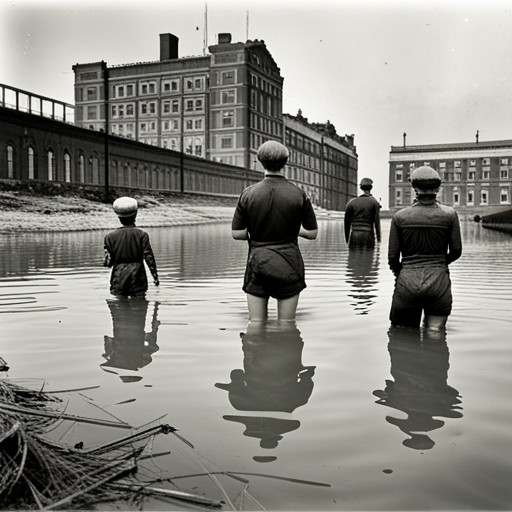The Governments Hand in the Camp Lejeune Water Crisis
This article investigates the government's involvement in the Camp Lejeune water crisis. It details the government's role, efforts made to address the situation, and impacts on local residents.

By examining this case study in-depth, potential policy implications and lessons for future environmental crises can be discerned.
Key Takeaways
- Government officials' actions and decisions significantly influenced the course and outcome of the environmental disaster.
- Lack of immediate response allowed for continued exposure to harmful chemicals.
- Serious questions arise about Crisis Management strategies followed by authorities.
- There was an apparent lack of mechanisms to swiftly respond and mitigate risks.
Understanding the Camp Lejeune Water Crisis

A comprehensive understanding of the Camp Lejeune Water Crisis necessitates a thorough examination of the role played by governmental agencies in this environmental and health calamity. The crisis, which unfolded over several decades from the 1950s to 1980s at a US Marine Corps base in North Carolina, involved prolonged exposure of military personnel and their families to contaminated water.
The primary contamination sources were volatile organic compounds (VOCs), specifically perchloroethylene (PCE) and trichloroethylene (TCE). These industrial solvents had seeped into groundwater used as drinking water due to improper disposal practices. It is estimated that approximately one million people may have been exposed to these toxicants.
Health consequences resulting from such extended exposure are severe. Evidence suggests links between VOC exposure at Camp Lejeune and various health conditions including kidney cancer, adult leukemia, non-Hodgkin's lymphoma, liver cancer, bladder cancer, multiple myeloma, Parkinson's disease among others. Children born during the contamination period also experienced higher occurrences of neural tube defects.
Governmental agencies' responses were marked by delays and lack of transparency. Despite initial findings of contamination in 1980, it was not until 1985 that measures were taken to shut down tainted wells. Further exacerbations included inadequate communication about potential health risks with affected individuals.
The Role of Government in the Crisis

Involvement of public officials in the environmental disaster was evident, with their actions and decisions significantly influencing its course and outcome. This occurrence underlines the significance of Government Accountability in situations that pose considerable risk to public health.
During the crisis at Camp Lejeune, a series of decisions made by those in power had detrimental impacts on both environment and human life. Despite awareness about contamination of water sources, lack of immediate response allowed for continued exposure to harmful chemicals among residents.
The failure to act promptly raises serious questions about Crisis Management strategies followed by authorities. There seemed to be an apparent lack of mechanisms to swiftly respond and mitigate risks associated with environmental disasters. Inadequate measures taken during the initial stages led to an escalation in the severity of effects caused by contaminated water consumption.
Furthermore, it is necessary to scrutinize transparency levels maintained by government officials during this crisis. Crucial information regarding potential hazards remained concealed from affected communities, thereby infringing upon their right to know and take precautionary measures.
Through an analysis of these aspects, it becomes evident that there were significant lapses in maintaining Government Accountability throughout this ordeal. Such incidents underscore an urgent need for stringent regulations ensuring timely actions are taken when facing crises; highlighting the importance of effective Crisis Management practices exercised by governing bodies.
Efforts to Address and Resolve the Crisis

Efforts to mitigate the detrimental impacts of the environmental disaster encompassed various strategies, including comprehensive investigations, legal proceedings, and implementation of preventive measures for future occurrences. Legislative actions played a crucial role in ensuring proper administration of justice by holding accountable those responsible for the Camp Lejeune water crisis.
Crisis management was also a significant aspect in handling this calamity. In 2012, a law named The Honoring America's Veterans and Caring for Camp Lejeune Families Act was passed. This legislative action made provisions for medical care to affected military personnel and their families who were exposed to contaminated drinking water at the base between 1957-1987.
In terms of addressing health concerns, specific programs were initiated by agencies such as Agency for Toxic Substances and Disease Registry (ATSDR) which conducted studies on adverse health effects caused due to exposure to volatile organic compounds found in Camp Lejeune's drinking water supply. Their findings facilitated the development of effective treatment plans.
Furthermore, systematic efforts were undertaken by Environmental Protection Agency (EPA) towards identifying sources of contamination and instituting preventive measures against future contaminations. These included stringent monitoring systems and improved regulation compliance among industrial entities.
Consequently, through collective efforts involving legislative actions and efficient crisis management strategies; substantial progress has been achieved in mitigating damages caused due to this environmental disaster while safeguarding public health from similar incidents in future.
Impact on the Residents of Camp Lejeune

Exposure to contaminated drinking sources significantly impacted the health and wellbeing of local residents, leading to a variety of chronic conditions and diseases. The toxic elements found in the water supply at Camp Lejeune had deleterious effects on human health, causing numerous types of cancers, neurological disorders, and birth defects. The extent of these health consequences became apparent over time as an increasing number of residents developed severe medical conditions.
Research studies conducted by various health organizations revealed a strong correlation between the exposure duration to polluted water and the severity of health problems. Individuals who drank or used this contaminated water for longer periods exhibited more serious symptoms compared to those with lesser exposure times. Pregnant women exposed to the toxicity bore children with congenital disabilities or infant mortality.
In response to this alarming public health crisis, compensatory measures were put into place by both governmental agencies and non-governmental organizations. These included providing financial compensation for affected individuals through legal mandates such as the Janey Ensminger Act that ensures healthcare coverage for victims.
Efforts were also made towards remediation activities aimed at purifying the tainted water resources within Camp Lejeune. While these steps have been pivotal in mitigating further harm from this environmental hazard, they fall short in erasing years of damage inflicted upon unsuspecting victims exposed to contaminated drinking sources.
Lessons Learned and Policy Implications

Learning from this catastrophic event has resulted in substantial policy implications, highlighting the need for stringent environmental regulations and proactive measures to safeguard public health. The Camp Lejeune water crisis underlined the urgent necessity of effective policy reforms that could prevent a recurrence of such devastating incidents.
The accountability measures put into place after the crisis have been centered around improving drinking water safety standards. Regulatory bodies have set stricter guidelines for permissible levels of chemicals in groundwater sources. This includes those substances linked to cancer and other serious illnesses, which were previously found in excess at Camp Lejeune.
Moreover, transparency in information sharing has become a focal point of these reforms. Public entities are now obliged to disclose any potential dangers related to water quality promptly and accurately. This shift towards greater openness aims at giving citizens an opportunity to make informed choices about their health.
Further policy changes targeted institutional accountability mechanisms by reinforcing consequences for non-compliance with environmental standards. These include rigorous inspection protocols, heavy penalties on violators, and legal recourse for victims. Such measures aim not only at deterring negligent behavior but also restoring public trust in governmental institutions' ability to protect their welfare.
In essence, lessons learned from the Camp Lejeune incident have facilitated significant policy improvements concerning environmental safety and public health protection strategies. Although the path towards full implementation may be challenging, these reforms signify crucial steps toward ensuring no community would have to endure similar hardships due to preventable oversight or negligence.
Frequently Asked Questions
What Other Military Bases Have Experienced Similar Water Contamination Issues as Camp Lejeune?
Several military bases have faced water contamination issues similar to Camp Lejeune. Notable instances include Fort Detrick, Naval Air Station Fallon, and Pease Air National Guard Base, highlighting a broader issue of base accountability and military pollution.
What Kind of Medical Support Is Being Provided to the Affected Residents of Camp Lejeune?
Medical support for affected Camp Lejeune residents involves veteran advocacy efforts and compensation lawsuits. These measures aim to address health issues linked to the water contamination incident, providing financial assistance and therapeutic care options.
Are There Any Non-Governmental Organizations Involved in Addressing the Camp Lejeune Water Crisis?
In relation to the Camp Lejeune water crisis, various non-profit interventions have been initiated. These organizations also conduct public awareness campaigns, supplementing efforts to address the environmental and health impacts of this significant issue.
What Specific Chemicals Were Found in the Camp Lejeune Water Supply and What Are Their Potential Health Effects?
Chemical Detection Methods revealed the presence of trichloroethylene, benzene, and vinyl chloride in Camp Lejeune's water supply. Health Impact Studies associate these chemicals with potential adverse effects such as liver damage, cancer and neurological disorders.
How Are the Current Residents of Camp Lejeune Being Assured of Their Water Safety?
Current residents of Camp Lejeune are ensured water safety through stringent water filtration methods and implementation of preventive measures, including regular testing and monitoring for potential contaminants in the water supply.
Conclusion
The Camp Lejeune water crisis illustrates the critical role of government oversight in public health. Despite initial failures, subsequent remedial efforts underscore the necessity for accountability and proactive measures.
The profound impact on residents necessitates strengthened policies to prevent future occurrences. This incident serves as a stark lesson about the potential consequences of neglecting environmental concerns, reinforcing the importance of stringent regulations for protection of public health.

This post has been generated by AI and was not reviewed by editors. This is Not legal advice. Please consult with an attorney.



